|

Summary of the results
WHO took part in the study?
New Zealand
One-hundred-and-fifty undergraduate psychology students from Victoria University of Wellington participated in this study as partial fulfilment of course requirements. 73 percent of them were female, and their average age was 20.1 years (SD=5.1).
People in the New Zealand sample particularly liked International Rock, Pop Music, and R'n'B, and they least liked Waiata, Gothic and Folk Music.
Brazil
Four-hundred-and-three Brazilians from Rio and Brasilia participated in this study. 70 percent of them were students, 54 percent were female, and their average age was 24.5 years (SD=8.7).
People in the Brazilian sample particularly liked MPB (Música Popular Brasileira), International Pop and Música Romântica, and they least liked Metal, Marchinha and Música Caipira.
Philippines
Two-hundred-and-eighty students from universities in Manila, Bacolod and Dumagette participated in this study. 73 percent of them were female, and their average age was 19.2 years (SD=3.2).
People in the Filipino sample particularly liked OPM (Original Pilipino Music), International Pop and R'n'B, and they least liked Electronica, Kulintang and Tunog Lata.
Germany
One-hundred-and-seventy-two people from all over Germany participants in this study (via an online-survey). 71 percent of them were students, 57 percent were female, and their average age was 22.5 years (SD=6.3).
People in the German sample particularly liked International Rock music, Indie, Jazz and Blues, and they least liked Volksmusik, Schlager and Techno music.
WHAT did I find out?
The aim of the study was to answer following two research questions:
1. Are preferences for international music styles (consistently) linked to values?
2. Are preferences for national music styles related to national identity across cultures?
Before I start answering those questions, two other issues should be discussed: first, what VALUES am I actually talking about? Then, I look at the music preferences in those four cultures - are music preferences comparable across cultures?
What values am I talking about?
Human values are “desirable, transsituational goals, varying in importance, that serve as guiding principles in people’s lives” according to the social psychologist and value researcher Shalom Schwartz (1996, p. 2). His theory of basic human values proposes that 10 basic value types exist universally: power, achievement, hedonism, stimulation, self-direction, universalism, benevolence, tradition, conformity and security (e.g., Schwartz, 1992). As illustrated in the diagram below, the 10 values types are organized in a circular structure. This circle emerges from complementary relationship of neighbouring values (e.g., power and achievement) and conflicting relation of opposing values (e.g., self-direction and security). The circular structure of 10 values types is due to two underlying basic value dimensions: the horizontal dimension is represented by the two conflicting poles of openness to change vs. conservatism, and the vertical dimension is represented by the two conflicting poles called self-transcendence vs. self-enhancement (for details see e.g., Schwartz, 1992).
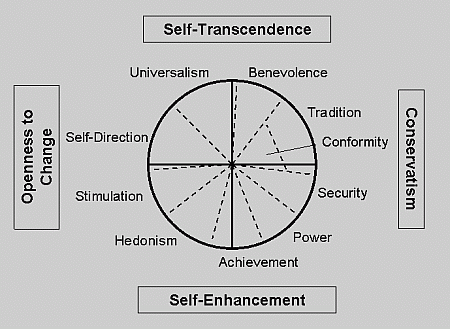
When talking about values in the following section I will only refer to the two basic value dimensions: conservatism vs. openness to change and self-transcendence vs. self-enhancement. If a person endorses conservative values, it means that he or she values tradition (e.g., by being humble, devout, respect for tradition, being moderate), security (e.g., family security, national security, social order) and conformity (e.g., politeness, being obedient, self-discipline). If a person endorses openness to change values, it means that he or she strives for stimulation (such as, excitement, novelty, and challenge in life) and self-direction (such as, independent thought and action choosing, creating, exploring). Furthermore, persons who endorse self-enhancement values pursue power (e.g., social status and prestige), achievement (by being successful, capable, ambitious, influential) and hedonism (such as, pleasure, enjoying life) in their life. On the contrary, endorsing self-transcendence values involves pursuing universalism (such as wisdom, social justice, equality, a world at peace, a world of beauty, unity with nature) and benevolence (such as being helpful, honest, forgiving, loyal, responsible).
Music preferences across four cultures
For each of the four samples I looked at the structure of preferences for national music styles and international music styles. Through looking at the structure, we can see which music style is usually preferred simultaneously with other music styles. Music styles that are related to each other lump together in statistical tests. In order to test the structure statistically, I did two factor analyses per country: one on national music styles and one on international styles.
Preferences for international music styles
Preferences for International music styles have the same structure in each of our four cultures. There are three distinct groups of music styles that are appreciated simultaneously: on the first factor we have Rock, Metal, Hardcore and Punk. On the second factor, we have Pop and HipHop and other popular rhythmic styles, like R'n'B. The third factor represents Classical, Jazz and Country music.
In all four samples, the three factor solution of international music preferences show appropriate psychometric properties (Total Variances explained 74, 51, 61 and 66 percent in New Zealand, Brazil, Philippines and Germany, respectively; internal reliability ranged from Cronbach's alpha .53 for Classic music styles in Germany to .86 for Rock music styles in the Philippines).
Preferences for national music styles
Preferences for national music styles in each country are divided into two factors: one for more traditional national music styles and one for more popular music styles from each country.
Traditional national music styles that are appreciated simultaneously in New Zealand are the Indigenous music styles Waiata, Kapa Haka and Polynesian Music. New Zealand Rock music, New Zealand Metal and New Zealand Dub are popular music styles that are also preferred at the same time.
More traditional national music styles that are appreciated simultaneously in Brazil are the Local music styles Maracatu, Bumba-Meu-Boi, Baião and Frevo. The popular Brazilian music styles are MPB (Música Popular Brasileira), Bossa Nova and Choro - loading on one factor.
Traditional national music styles that are appreciated simultaneously in the Philippines are Kundiman, Kulintang, Rondalla, Tunog Lata and Harana. The popular Filipino music styles that are enjoyed together are Pinoy Rock, OPM (Original Pilipino Music), Pinoy Metal and Pinoy HipHop.
More traditional national music styles that are appreciated simultaneously in the Germany are Schlager and Volksmusik. The popular German music styles that are enjoyed together are German Rock, German Punk, Hamburger Schule, Ostrock and Liedermacher.
Both factors, traditional and popular national music styles, have decent psychometric properties in all four cultures (Total Variances explained 74, 51, 61 and 66 percent in New Zealand, Brazil, Philippines and Germany, respectively; internal reliability ranging from Cronbach's alpha .63 for Popular New Zealand styles to .90 for Indigenous music styles in New Zealand).
In the following results section we will use our two national music factors (traditional and popular) and our three international music factors (Rock, Pop and Classics).
Music preferences and values
The research question I would like to answer now is: are preferences for international music styles (consistently) linked to values? I answer this question in three steps looking at the value orientations endorsed by people who like listening to Rock, Pop and Classical music, respectively.
Let's start with people who like Rock music.
Preferences for Rock and Metal music are negatively related to conservative values. Correspondingly, preferences for Rock and Metal music are positively associated with openness to change values. This means, fans of international rock and metal are likely to pursue stimulation (such as, excitement, novelty, and challenge in life) and self-direction (such as, independent thought and action choosing, creating, exploring), whereas they do not value tradition (e.g., by being humble, devout, respect for tradition, being moderate), security (e.g., family security, national security, social order) and conformity (e.g., politeness, being obedient, self-discipline).
The link between Rock music and openness to change values can be considered consistent although this link was not statistically significant in the Philippines and in New Zealand. No consistent link was found between a preference for rock music and self-transcendence values. Liking Rock and Metal music was only linked to endorsing self-transcendence value orientations in Germany. The more Germans disapproved of self-transcendence values the less they were likely to appreciate international Rock and Metal music.
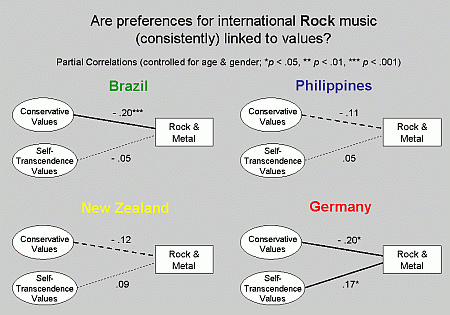
Coming to Pop and Hip Hop music: in our two western cultures, New Zealand and Germany, international Pop and Hip Hop music was negatively correlated with self-transcendence values, and positively correlated with self-enhancement values. However, this link did not occur in both non-western cultures, Brazil and Philippines. Pop and Hip Hop is consistently not related to the conservative value dimension - the extent that someone is conservative or open has no implications for how much they enjoy international Pop and Hip Hop music.
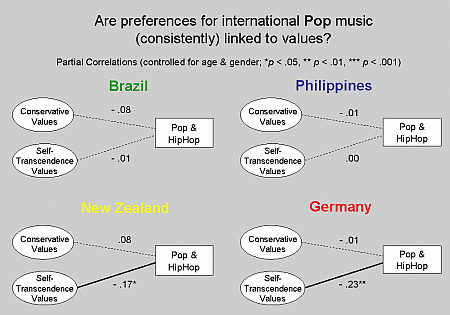
Preferences for international Classical music and Jazz were not consistently related to conservative or openness to change values. In Brazil, a preference for Classical music and Jazz indicated that a person endorsed openness to change values. Contrary, a preference for Classical music and Jazz implied that a person endorsed conservative values in the Philippines. In all countries except Brazil, self-transcendence values related to the appreciation of Classical music. The more Germans, Filipinos and Kiwis endorsed self-transcendence values, the more they liked Classical music and Jazz. This result also means that the more they endorsed self-enhancement values, the less they liked Classical music and Jazz. However, I cannot conclude that the link between self-transcendence values and appreciation for Classical music is universal. This is due to two reasons. First, the correlation between a preference for international Classical music and self-transcendence values was not strong enough (or statistically significant) in Germany. Second, there is no reasonable explanation why the link between self-transcendence and appreciation for Classical music did not appear in Brazil.
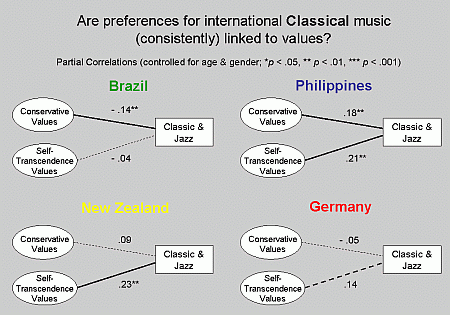
Music preferences and national identity
The second research question was: are preferences for national music styles related to national identity?
First, liking traditional music styles was related to higher national identity in the Philippines, in New Zealand and in Germany. This is shown by the significant partial correlations between traditional music styles and national identity in the diagram below. Specifically, people who identify strongly with their country are likely to enjoy traditional national music styles in these three countries. However, this is not the case in Brazil. This may be due to the selection of traditional music styles that are present only in specific regions of Brazil (Maracatu, Bumba-Meu-Boi, Baião and Frevo). Therefore, these music styles might be related to local identities rather than identification with the whole country.
Looking at popular national music styles, I found a significant link to national identity in Brazil and Philippines, whereas popular styles are not related to national identity in Germany or New Zealand. This means that the more Brazilians and Filipinos identify with their country, the more they enjoy popular Brazilian and Filipino music, respectively.
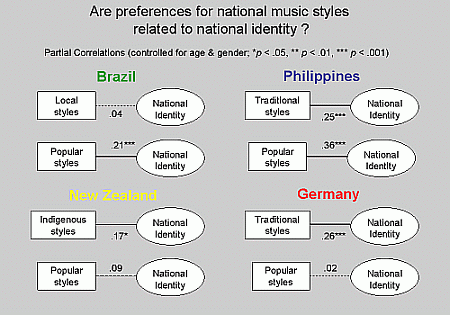
In summary, individuals' preferences for traditional music styles can be interpreted as indicators or symbols of identification with one's country in the Philippines, in New Zealand and in Germany. More precisely, the more someone from the Philippines, New Zealand or Germany is proud of his or her country, the more he or she likes Kulintang, Kapa Haka or Volksmusik; or vice versa.
Furthermore, popular music styles can be symbols of commitment to one's country. This is the case in our two non-western samples from Brazil and the Philippines. The more someone from Brazil or the Philippines identifies as Brazilian or Filipino, the more he or she enjoys listening to MPB (Música Popular Brasileira) or OPM (Original Pilipino Music), respectively.
References
Schwartz, S. H. (1996). Value priorities and behavior: Applying of theory of integrated value systems. In C. Seligman, J. M. Olson, & M. P. Zanna (Eds.), The Psychology of Values: The Ontario Symposium, Vol. 8 (pp.1-24). Hillsdale, NJ: Erlbaum.
Schwartz, S. H. (1992). Universals in the content and structure of values: Theory and empirical tests in 20 countries. In M. Zanna (Ed.), Advances in experimental social psychology (Vol. 25) (pp. 1-65). New York: Academic Press.
[Show overview of results...]
[what is the study about...]


[more...] [take part...]


[more...] [results...]

|
|


You are warmly invited to take part in my new study about your daily life experience with music. It takes about 10 minutes to fill in the survey.
|
|































